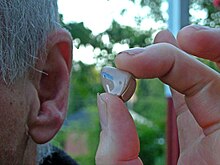Musical ear syndrome
Musical ear syndrome (MES) describes a condition seen in people who have
Causes
It is postulated that by the "
The hallucinations are usually not unpleasant but may irritate due to their persistent nature. It is common for sufferers to have a history of tinnitus.[5]
Investigations such as
MES may occur even when there are little to no symptoms derived from medical testing.[8]
Treatment
Given the unknown nature of MES, treatments have been largely dependent on an individual basis. Treatments can vary from being as little as self-reassurance to pharmaceutical medications.[1]
Medications can be helpful, such as
Other than treatment by medicinal means, individuals have also successfully alleviated musical hallucinations by cochlear implants, listening to different songs via an external source, or attempting to block them through mental effort, depending on how severe their condition is.[9]
Hallucinations can be reduced by providing the brain with a percentage of the lost input from hearing loss, and patients can maximize their hearing capability by utilizing hearing aids. Hearing aids can make up some of the patients' hearing loss, and potentially alleviate these musical hallucinations.[8] However, this is not effective for all patients.[10]
It is believed that non-drug treatment options are better than drop options for the elderly population that may suffer from MES.[8]
Populations
The occurrence of MES has been suggested to be very high among the hearing impaired through acquired deafness or the ear condition known as tinnitus.[4] Though exact causation is uncertain, it has been theorized that the "release phenomenon" is taken into effect. The "release phenomenon" says that individuals with acquired deafness may experience musical hallucinations because of the lack of stimulation, which can give room for the brain to interpret internal sounds as being external.[11]
Sufferers typically hear music or singing and the condition is more common in women.
Due to the high correlation with hearing loss, MES is common in the elderly due to their often depreciating hearing abilities.
History

Musical hallucinations and MES have only become widely recognizable in the last few decades of research, but there are indications throughout history that have described symptoms of musical hallucinations. The Romantic composer Robert Schumann was said to have heard entire symphonies in his head from which he drew as inspiration for his music, but later in his life this phenomenon had diminished to just a note that played ceaselessly within his head.[9] An alternative explanation is that his symptoms were caused by syphilis or mercury poisoning used for its treatment. The Russian composer Dmitri Shostakovich was also recorded as experiencing music hallucinations after some shrapnel was removed from his skull.[9]
MES is typically a harmless disease, but can be somewhat disturbing to patients, and can disrupt their quality of life. MES is not considered a mental illness, but rather a side effect of hearing loss.[8]
See also
- Apophenia – perceiving a pattern where none exists
- Pareidolia – perceiving coherent sounds in random noises
References
- ^ S2CID 206237070.
- PMID 7041567.
- PMID 15679215.
- ^ S2CID 20714997.
- S2CID 3210326.
- ^ PMID 22561476.
- ^ PMID 21155649.
- ^ PMID 28360776.
- ^ a b c Sacks, Oliver (2008). Musicophilia: Tales of Music and the Brain. New York: Vintage Books.
- S2CID 9308059.
- PMID 23968300.
- ^ "Musical hallucination (musical tinnitus)". British Tinnitus Association. Retrieved 2022-04-15.
